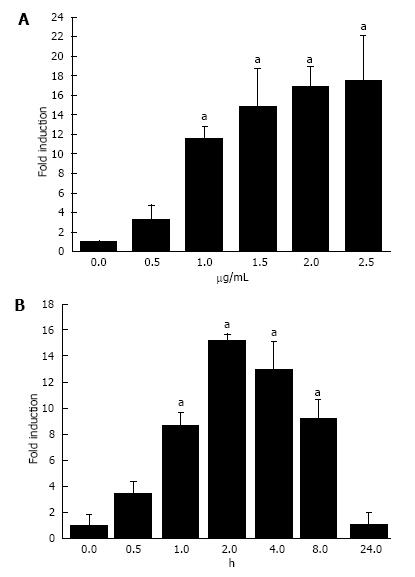Copyright
©The Author(s) 2016.
World J Gastrointest Pharmacol Ther. Nov 6, 2016; 7(4): 540-549
Published online Nov 6, 2016. doi: 10.4292/wjgpt.v7.i4.540
Published online Nov 6, 2016. doi: 10.4292/wjgpt.v7.i4.540
Figure 2 Relative A20 mRNA ratio in HT-29 cells after lipopolysaccharide stimulation with different doses or different time points.
CT was calculated for the genes of interest and for the housekeeping gene GAPDH. For each cDNA sample, the CT for GAPDH was subtracted from the CT for each gene of interest to obtain the parameter ΔCt, thereby normalizing the initial amount of RNA used. The amount of each target was calculated as 2ΔΔCt, where ΔΔCT is the difference between the ΔCT of the two cDNA samples to be compared. A: Cultured HT-29 cells were stimulated with LPS at different doses for 1 h, and the results showed that the expression of A20 was increased with increasing amounts of LPS stimulation. aP < 0.05 vs non-stimulated cells; B: HT-29 cells were treated with 1 μg/mL LPS at various time points (0-8 h). The expression of A20 was very low in HT-29 cells without LPS stimulation but was rapidly increased and peaked at 2 h. aP < 0.05 vs non-stimulated cells and cells stimulated for 24 h. LPS: Lipopolysaccharide.
- Citation: Zheng CF, Shi JR, Huang Y, Wang SN. A20 inhibits lipopolysaccharide-induced inflammation in enterocytes. World J Gastrointest Pharmacol Ther 2016; 7(4): 540-549
- URL: https://www.wjgnet.com/2150-5349/full/v7/i4/540.htm
- DOI: https://dx.doi.org/10.4292/wjgpt.v7.i4.540









